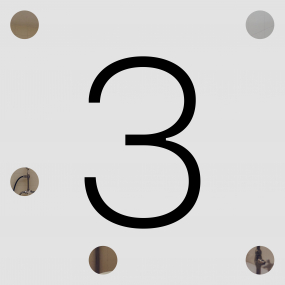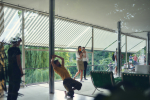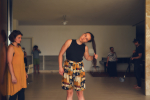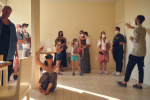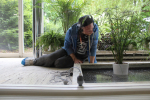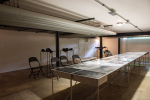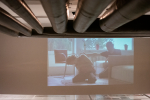The third interpretation titled RUPTURES/SITUATIONS: Moving and Listening to the Everyday of Villa Tugendhat is presented by authors AVA collective & Move the City.
A normal visit to Vila Tugendhat is a familiar serialised experience for visitors, where the villa is presented within a familiar conventional framework of culturally valuable architectural details. Our group works with introspective and extended modes of perceiving the individual in a space through sound and movement practices of changing attention. These can lead to unique personal experiences without direct visual connections to the villa environment through movement and meditative practices of authentic movement or active listening. At the same time, this altered perception and new layers of meaning can be conveyed to a wider audience through the resulting film collage.
The project can be divided into two interconnected units. The first consists of active listening (deep listening, a concept created and popularized by the American composer and theorist Pauline Oliveros), acoustic research and subsequent capture and amplification of the sounds of objects, materials and the space of the villa. While the resulting sound collage is based on the acoustic experience inside the villa and its sound parameters, it creates a new, unique and speculative sonic content.
Further possibilities of reinterpreting and deconstructing the perception of the space in the villa are addressed in the second line – movement research conducted using the method of authentic movement, which offers a different way of relating to the space and experiencing it, among other things, with closed eyes. Architecture in this concept is not a source of direct inspiration for movement, but the environment where movement and the introspective and meditative experience associated with it takes place. The culmination of our movement and sound exploration of the everyday life of the villa and the collaborative public workshop will result in a film collage combining sound and video recordings and a live improvised sound installation in the space of the villa.
Outputs of interpretation:
- sound research and installation capturing the sound properties of the objects, materials and space of the villa, as well as the movements of the performers and visitors
- movement research – the technique of authentic movement allows for deep meditation in the room, relaxation in movement and under the influence of a particular environment. How does the body respond to a specific space? Participants will create meaning-making situations through their movement with their eyes closed, without a primary relationship to the architecture of the villa.
- visual recording of a sound-motion performance – using video footage of the movement research and everyday life of the villa, and with the contribution of recorded sounds, a film will be created in which unconscious movement overlaps into the architecture will be further developed in meaning through editing using other contexts and associations.
- a workshop focusing on authentic movement and active listening (deep listening) – closed eyes can completely change the way we perceive space - the absence of rational analysis through sight can induce a deep sensory experience. The participants of the research workshop will experience Villa Tugendhat with their eyes closed in a different way than we know from the tours.

AVA collective (photo: Polina Davydenko); Move the City
SCHEDULE:
19 July 2021 workshop of authentic movement with Move the City and deep listening with AVA collective
21 July 2021, 4:00 and 5:00 p.m. special tours of the villa with Move the City movement research
31 August 2021, 6:00 p.m. exhibition opening with a sound performance by AVA collective
1 September – 26 September 2021 exhibition of the results of sound and movement research on the technical floor of Villa Tugendhat (open Tue–Sun 10:00–17:30 for 50 CZK)
Concept and sound intervention: Martin Bukáček and AVA collective (Martin Bukáček, Marek Salamon, Andrej Nechaj, Matěj Kotouček, Simo Hakalisto)
Concept and motion research: Petra Hlaváčková, Michaela Ondrašinová, Lucie Sendlerová, Roberta Štěpánková (Move the City – 4AM / Forum for Architecture and Media; facebook.com/movethecityfestival, forum4am.cz)
Film collage: Tomáš Hlaváček, Petra Hlaváčková
Participants in movement research: Patricie Pažická, Alice Šimečková, Petr Sič, Zdeněk Rosenberg, Petra Klementová
Authors of the concept and production of exhibitions: Barbora Benčíková, Ludmila Haasová, Neli Hejkalová, Lucie Valdhansová (Villa Tugendhat Study and Documentation Centre)
Curator: Neli Hejkalová
Graphic design: Atelier Zidlicky
Project photographer: Mizuki Nakeshu
Translation: Kateřina Báňová
instagram.com/moznosti_interpretace
The project is financed by the Ministry of Culture of the Czech Republic.


![]()
Authors:
Martin Bukáček is one of the key personalities of AVA collective and also of Corinth and Lifeliqe companies dedicated to the creation of interactive 3D teaching aids.
AVA collective is a group operating since 2009, dedicated to experimental music presented in non-traditional locations, creating special experiences approaching a form of ritual. Site-specific approach is important for them.
facebook.com/avantyry, corinth3d.com, lifeliqe.com
Petra Hlaváčková is an art historian, curator, documentary filmmaker and journalist whose work is strongly rooted in architecture, urbanism and feminist theory. She is the initiator of Move the City, a research workshop focusing on movement and dance improvisation in the city, dance interpretation of architectural space and exploring the relationship between movement and voice. Move the City is one of the many activities of the 4AM Forum for Architecture and Media – an open platform for experimental approaches and diverse activities related to architecture, urbanism, urban space, contemporary art and new media art.
Tomáš Hlaváček studied philosophy and media studies at Masaryk University in Brno and documentary filmmaking at FAMU. He works as an independent documentary filmmaker and focuses on critical coverage of contemporary political, social and socio-cultural issues. In his documentaries, he penetrates the environment of ethnic minorities and social subcultures (When you have a job, you have everything, 2016, Stadium 2018, We are the epicentres of earthquakes (2020), Living against everyone, 2021). He is also involved in experimental documentary approaches, especially the so-called spontaneous film / diary movies (Panta Rhei, 2016, Information, 2017, Documagination 15>17, 2018).
Michaela Ondrašinová is a religions scholar with a passion for dance. Her ethnographic research focuses, among other things, on the discourse of female nature in centres of spiritual development and the related rewriting of gender identities. She is part of the Brno-based dance group Filigrán (contemporary dance, improvisation) and the collective around the Contact Improvisation Laboratory; under the direction of Roberta Štěpánková, she works on instant compositions. She is co-author of the Move the City research workshop. She is interested in somatic and movement techniques that allow a deeper dive into the universe of the body.
Lucie Sendlerová holds a BA in Arts du Spectacle with a focus on contemporary dance from the University of Paris 8 Vincennes-Saint Denis. She was a long-time member of the Brno dance group Filigrán. She collaborates with the 4AM Forum for Architecture and Media on Move the City, a research workshop focused on movement and improvisation in the city and the movement interpretation of architectural space. Through dance she has developed a deeper interest in the body. She currently practices shiatsu and is interested in Chinese medicine.
Roberta Legros Štěpánková is a performer and choreographer, educator and body-oriented psychotherapist. She studied dance under Melanie Venino (DE/FR) and David Finelli (IT/FR) in Valencia, Spain and later combined physical bodywork with psychotherapy and studied Dance-Movement Therapy at CODARTS University for the Arts in Rotterdam, The Netherlands (2012–2015). Roberta has been working with the body in the context of theatre, dance and healing since 2009, and has been creating her own intimate dance performances since 2017. Roberta regularly teaches dance – a technique of improvisation with a conscious transition into the art of instant composition. Since 2020 she has been teaching "The Art of Movement" at the Studio of Physical Theatre at the Theatre Faculty of JAMU in Brno.
